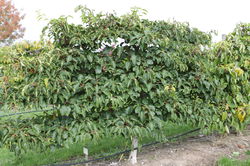 When you hear the word 'kiwi', you almost inevitably think of the large, green-brown, hairy fruits from the supermarket, which are now available all year round. It doesn't matter whether it's the green- or yellow-fleshed variety. Both look quite similar at first glance.
When you hear the word 'kiwi', you almost inevitably think of the large, green-brown, hairy fruits from the supermarket, which are now available all year round. It doesn't matter whether it's the green- or yellow-fleshed variety. Both look quite similar at first glance.
Our range of hardy kiwi young plants, on the other hand, has a much greater variety of shapes and colours. In the portrait article on hardy kiwis we have already acquainted you to this equally fascinating and easy-to-grow group of plants. Now we would like to introduce you to our range of hardy kiwi young plants in more detail.
Hardy kiwi young plants from German breeding
Our current hardy kiwi varieties have been selected and brought to market in cooperation with the plant hunter and kiwi breeder Mr Werner Merkel from Chemnitz, the Sämann nursery in Bautzen and the Bavarian State Institute for Viticulture and Horticulture (LWG) in Veitshöchheim.
The first selection of this new generation of hardy kiwi young plants was made personally by Mr Merkel. The most promising of his selections were then planted in the 'Stutel' orchard trial farm of the LWG Veitshöchheim. Several years and several selection rounds later, the best selections were finally chosen and our new hardy kiwi young plant assortment was born. However, our assortment requires more effort than these few lines would suggest.
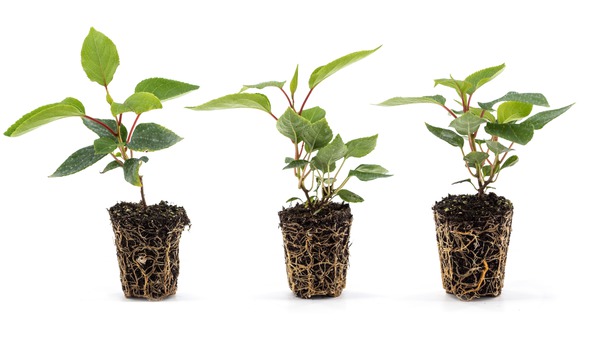
Picture: Quality of our kiwi berry young plants
Mr Merkel and the kiwis
The private breeder, plant collector and kiwi enthusiast Werner Merkel from Chemnitz is in charge of crossing, obtaining and raising the seedlings as well as the initial selection. For about 40 years now, he has been collecting the different mini kiwi species worldwide in order to actively carry out crossings with them.
Always with the aim of:
- to increase fruit size and plant yields
- to improve winter hardiness
- to obtain more attractive fruit colours, e.g. by crossing red-fruited species
The Lubera Edibles hardy kiwi young plants
What started in the early 1990s with the Bavarian kiwi 'Weiki' that was selected in Weihenstephan, we continued with our improved range of hardy kiwi young plants. However, we are far from finished. As with all of our assortments, we are also working on constantly improving our hardy kiwi young plants. So we currently have some promising selections in the variety trials, apart from the numerous seedlings in Veitshöchheim.
The “self-fertile” varieties
The self-fertility of kiwi plants is a topic that can already be referred to the whole genus and not only to the hardy kiwi or the large-fruited fuzzy kiwi, not to mention, it is always a cause for discussion.
Basically, it can be said that kiwi plants are dioecious by nature, so on the one hand there are purely female plants from which we harvest the fruit. And on the other hand, there are purely male plants that (almost) exclusively serve as pollinators. But where then does the recurring discussion about self-fertility come from? As everywhere, there are exceptions to the rule with kiwi plants. For example, there are varieties that produce male flowers but then go on to produce fruit; this is due to the biology of the kiwi flowers. This is because the male flowers can also have rudimentary female flower organs, from which the fruit then forms. As a rule, however, this fruit formation does not take place through conventional fertilisation by male pollen, but rather through the process of 'parthenocarpy', the so-called production of fruit without the fertilisation of the ovules. This behaviour can also be observed in purely female flowers. This is the case with our hardy kiwi variety 'Super Issai', which has a similar genetic origin as the variety 'Issai'.
In addition, container plants have also been sold as self-fertile, where one female and one male plant have been potted together. This is quite feasible and is still done occasionally, but it should be communicated in exactly the same way, since this has nothing to do with self-fertility.
Hardy Kiwi Kiwiberry® 'Super Issai'
The KiwiBerry® ‘Super Issai’ is basically comparable to the variety ‘Issai’. The self-fertility, the somewhat weaker growth and also the fruit quality are very similar. However, there are also differences. 'Super Issai' is a 'precocious' fruit in comparison, because you can expect the first yields from the second year of growth, as long as you refrain from winter pruning in the first two years of growth. The ripening period is also somewhat earlier. 'Super Issai' can be harvested on average from mid-September, whereas 'Issai' can only be harvested from the beginning of October. Like the 'Issai' variety, 'Super Issai' is also particularly suitable for smaller gardens where there is simply no space for a male pollinator plant, but you still don't want to do without kiwi berries.
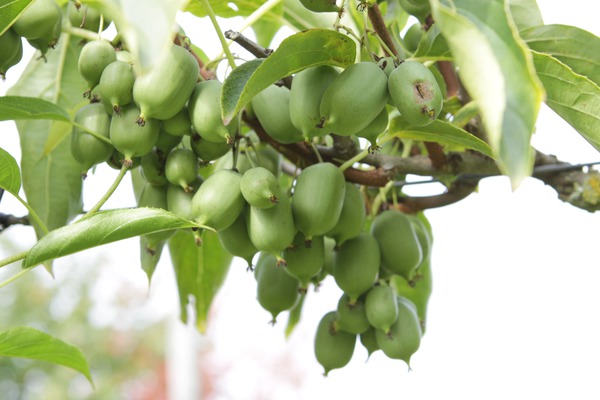
Picture: Kiwiberry® 'Super Issai'
Advantages of Kiwiberry® 'Super Issai'
- reliable yield even without a pollinator
- somewhat weaker growth than other mini kiwis
- first fruits often appear already in the 2nd year of growth
Short description of Kiwiberry® 'Super Issai'
Growth: vigorous, summer and winter pruning indicated
Ripeness/Harvest: from the beginning of October
Fruits: large, sweet, attractive light green fruit
Taste: a very sweet, juicy kiwiberry aroma
The female varieties with good yields
As already mentioned above, our hardy kiwi young plants are basically either female varieties or male varieties. Here we would like to introduce you to our range of female hardy kiwi young plants.
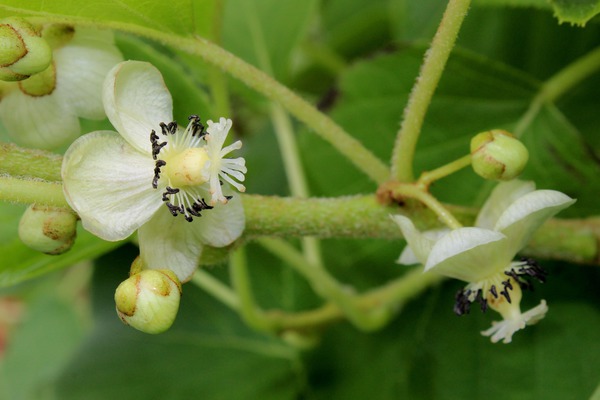
Picture: Female flower of a hardy kiwi - the pistils are clearly visible, which are not present in a male flower.
Compared to the varieties with a parthenocarpic disposition, the purely female varieties of hardy kiwi have the advantage that the fruits are significantly larger; fruit weights of 10 g and more are not uncommon with our current varieties. The larger, individual fruits naturally also increase the total plant yield. However, in order to achieve this fruit yield at all, the plants need to be much more vigorous and stronger. If there is such a thing as a negative aspect of the female varieties, it is their vigour.
Hardy Kiwi Kiwiberry® 'Pink Jumbo'
The mini kiwi variety 'Pink Jumbo' is the latest breeding success and actually a chance find. 'Pink Jumbo' is characterised by its large to very large fruits. When ripe, the fruits have striking pink-coloured skin in combination with an intense, light green flesh. The fruits are sugary sweet with only a very slight hint of acidity in the background and a profound fruity aroma.
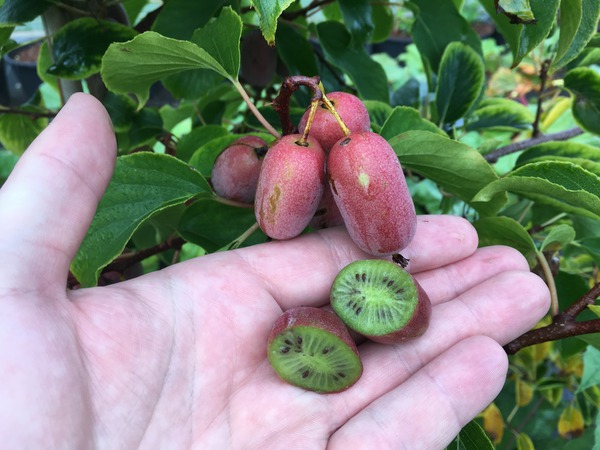
Picture: Kiwiberry® 'Pink Jumbo' - an attractive combination of pink skin and fresh green flesh.
Advantages of Kiwiberry® 'Pink Jumbo'
- the red-skinned mini kiwi with the largest fruits
- early onset of ripening
- great colour and fruity sweetness
Short description of Kiwiberry® 'Pink Jumbo'
Growth: strong growth, summer pruning necessary, but do not start until after the third year of growth.
Ripening/harvesting: ripens from mid-September and thus earlier than the green-skinned mini kiwis
Fruit: large to very large fruit in clusters; striking pinkish-pink skin and fresh green flesh; intense fruity-sweet aroma
Taste: fruity sweet with harmonious acidity
Hardy Kiwi Kiwiberry® 'Super Jumbo'
KiwiBerry® Super Jumbo lives up to its name, bearing the largest fruits of all Actinidia arguta mini kiwis. The fruits are green, hairless and somewhat elongated, similar to the summer kiwis (Actinidia kolomikta), which ripen already in August. 'Super Jumbo' also shows in its growth habit what its name promises: the strong growth requires space; training on a trellis makes sense and both winter and summer pruning are important. The first two years, however, the plant is not pruned, so that it yields more quickly. Speaking of yield: the variety needs a male pollinator plant nearby. However, this can be kept small with pruning as soon as the flower set is regular.
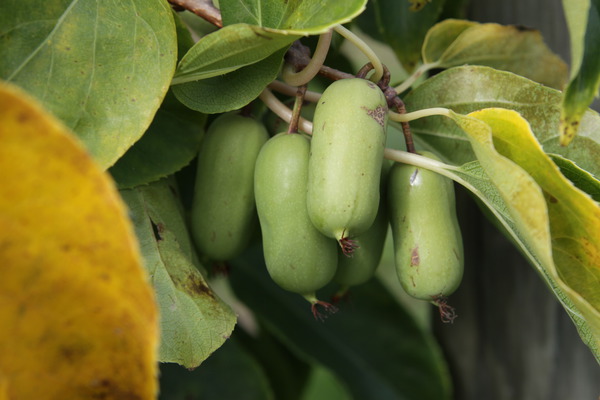
Picture: Kiwiberry® 'Super Jumbo' - currently the largest fruits in the assortment
Advantages of Kiwiberry® 'Super Jumbo'
- the green-skinned mini kiwi with the largest fruits
- robust and high-yielding
- absolutely hardy
Short description of Kiwiberry® 'Super Jumbo'
Growth: vigorous, summer and winter pruning indicated
Ripeness/Harvest: from the beginning of October
Fruits: large, sweet, attractive light green fruit
Taste: a juice bomb with fruity notes
Hardy Kiwi Kiwiberry® 'Fresh Jumbo'
The mini kiwi 'Fresh Jumbo' is a very valuable variety and sets new standards for yield and taste in the grape kiwi assortment. The fruit set of 'Fresh Jumbo' is very high. It starts in the 2nd or 3rd year and then increases continuously. From the 5th year onwards, the growth becomes permanently weaker as a result of the strong and regular yield. Compared to the other Jumbo varieties, 'Fresh Jumbo' is clearly weaker growing. Since 'Fresh Jumbo' is mainly occupied with fruit production, it forms fewer whip-like shoots. This makes it easier to keep the plant under control. 'Fresh Jumbo' also has a lot to offer in terms of taste. The very well-balanced ratio of sugar and acid makes this grape kiwi a pleasant, fruity culinary experience.
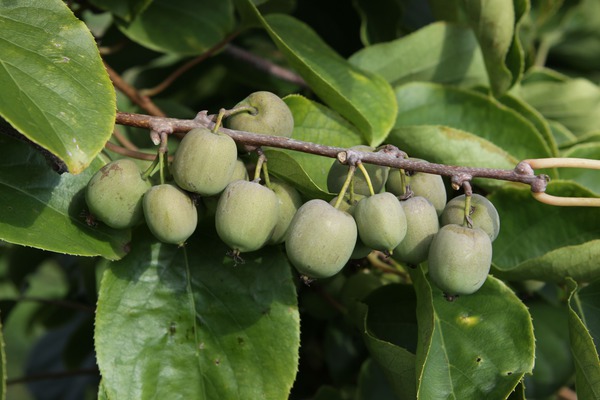
Picture: Kiwiberry® 'Fresh Jumbo' - the hardy kiwi fruit with the refreshing taste
Advantages of Kiwiberry® 'Fresh Jumbo'
- well balanced, fresh aroma
- regular and high yields
- hardly susceptible to diseases and absolutely hardy
Short description of Kiwiberry® 'Fresh Jumbo'
Growth: fast-growing, but rather weaker compared to the other jumbo varieties; Summer pruning absolutely necessary
Ripeness/Harvest: depending on the weather from the beginning of October
Fruits: needs pollinators! Fruits hang in clusters, medium-large, flat-apple-shaped, harvest whole clusters at a time
Taste: fresh taste thanks to the balanced sugar-acid ratio; Can be eaten directly from the bush and with the skin on
The red-fruited hardy kiwi varieties
In addition to the green-fleshed hardy kiwi varieties described above, red-fruited or red-fleshed hardy kiwi species/subspecies, in this case mainly Actinidia arguta var. prupurea and Actinidia melanandra, have been successfully crossed to obtain red-fleshed varieties with a good taste and good yields. What all red-fleshed varieties have in common is a significantly earlier ripening time than that of the green-fleshed varieties. Usually, the red varieties ripen about two weeks earlier, around mid-September.
Hardy Kiwi Kiwiberry® 'Red Jumbo'
KiwiBerry® Red Jumbo delivers on the inside what the fruits promise on the outside: the skin and flesh are red - and very aromatic, somewhat reminiscent of table grapes. Compared to 'Pink Jumbo', the fruits are more elongated, somewhat slimmer and smaller. The attractive colour of the 'Pink Jumbo' fruits comes from hybridisation with Actinidia purpurea. The variety requires a pollinator, but then delivers very regular and high yields. In good years, the harvest often starts as early as the beginning of September. As a strong-growing climbing plant, summer pruning is also mandatory for this mini kiwi.
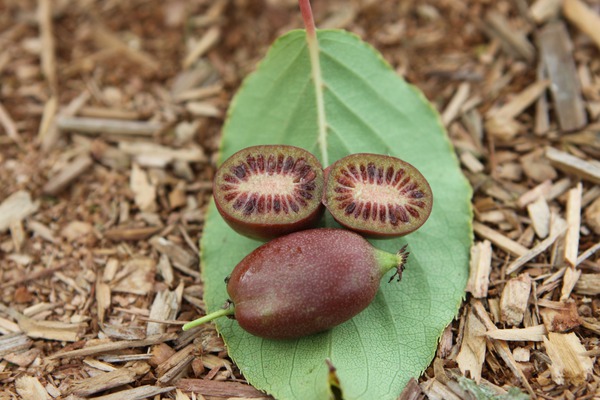
Picture: cut open fruit of Kiwiberry® 'Red Jumbo' - the red-fruited hardy kiwi
Advantages of Kiwiberry® 'Red Jumbo'
- fantastically beautiful, unusually red fruits
- very early ripening
- great taste (reminiscent of table grapes)
Short description of Kiwiberry® 'Red Jumbo'
Growth: fast-growing, summer pruning necessary, but only start after the third year of growth
Ripeness/Harvest: early ripening period, in good years possible from the beginning of September
Fruits: large, red-fleshed, oblong fruit
Taste: pleasant sugar-acid ratio
The male pollinator varieties – Kiwi berries with flowers but without fruit
In order to achieve high and consistent yields from the hardy kiwi varieties described above, a male pollinator partner is essential. With male varieties, it is not only the vitality of the plant or the number of flowers/pollen that play an important role. Above all, the flowering time of the male and female varieties must match so that pollination can occur at all. With our male hardy kiwi variety 'Prince Jumbo' we can offer a pollinator that is suitable as a partner for all the female varieties mentioned. After all, we do not want or need such complicated pollination tables for kiwi berries as we do for pome fruit, for example.
Hardy Kiwi Kiwiberry® 'Prince Jumbo'
KiwiBerry® Prince Jumbo is, so to speak, the magic prince for the female Jumbo varieties, but it can also be used as a reliable pollinator for all other Actinidia arguta. The cream white flowers appear in June. One plant is sufficient to pollinate several female mini kiwis, whereby the pollinator should ideally be only a few metres away from the female plants. Like all KiwiBerry® ‘Prince Jumbo’ has a vigorous growth, making summer pruning mandatory. If only one female plant needs to be pollinated, the male plant can be grown much smaller by rigorous pruning. However, one male hardy kiwi plant is sufficient to pollinate up to 5 female hardy kiwi plants.
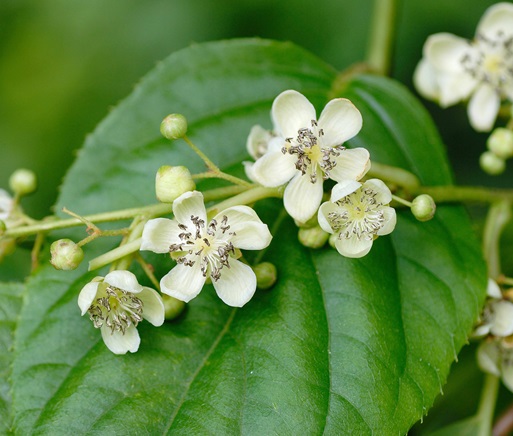
Picture: Male flowers of the pollinator variety Kiwiberry® 'Prince Jumbo' - the stamens and the missing pistils are clearly visible.
Advantages of Kiwiberry® 'Prince Jumbo'
- male pollinator for mini kiwis
- blooms abundantly and reliably
- healthy and vital
Short description of Kiwiberry® 'Prince Jumbo'
Growth: vigorous, summer pruning required
Ripeness/Harvest: male pollinator variety, no fruit set
What's next for the hardy kiwis?
With this new generation of hardy kiwi young plants, we have been able to significantly improve the fruit size and plant yield compared to the well-known 'Weiki', but this does not mean that we have reached the end of the development. There is still potential to be discovered in fruit size, fruit colour (on both the inside and outside) but also in taste. That is why we continue to test and evaluate new varieties and selections. We do this so that we will be able to offer an innovative assortment of hardy kiwi young plants in the future.
